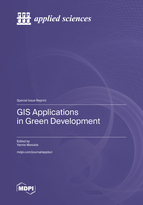GIS Applications in Green Development
A special issue of Applied Sciences (ISSN 2076-3417). This special issue belongs to the section "Environmental Sciences".
Deadline for manuscript submissions: closed (30 June 2023) | Viewed by 13072
Special Issue Editor
Interests: energy; environment; GIS; development
Special Issues, Collections and Topics in MDPI journals
Special Issue Information
Dear Colleagues,
Green development is the answer to the climate crisis. GIS, being the perfect platform for environmental monitoring and design, has extensive fields of application in climate adaptation, mitigation, and resilience. The interest is focused on basic human GHG emission activities: energy, industry and raw materials, digital agriculture, smart cities, transportation, and logistics. energy, with distributed renewable energy sources and energy efficiency/savings; industry and raw materials for decreasing CO2 emissions, transforming the production model by using green energy, improving recycling–reusing–reducing processes; digital agriculture, for decreasing usage of energy, water, fertilizers, and farming with sustainable methods; smart cities, being the future of the urban environment for 7 billion inhabitants, where 70% of GDP and CO2 emissions are produced, with the necessity of smart transportation arrangements, smart daily and long-term local governance, net-zero buildings, improvement of public infrastructures’ resilience, and low energy consumption processes; and transportation and logistics, with 32% of global GHG emissions, with new fuels and electrifying all transportation means from private vehicles to ships and airplanes.
All of the above, combined with GIS applications and information and communication technologies (ICT) offer a broader horizon for greening the production model in developed and developing countries. Artificial Intelligence, the Internet of Things, blockchain, 3D printing, robotics, and 5G telecommunication are only some of the most crucial advancements, bringing development on the market, as well as new and innovative applications for decreasing global temperature.
Smart GIS applications are the most important instruments in decision makers’ hands, in order to design and monitor the new local, national, and international climate circumstances. Since 75% of the Earth’s surface is affected by human activities, there is a huge necessity for a broader possible use of smart GIS applications in foreseeing impacts in forests, oceans, urban and rural areas, transportation and production sites, and networks.
Prof. Dr. Yannis Maniatis
Guest Editor
Manuscript Submission Information
Manuscripts should be submitted online at www.mdpi.com by registering and logging in to this website. Once you are registered, click here to go to the submission form. Manuscripts can be submitted until the deadline. All submissions that pass pre-check are peer-reviewed. Accepted papers will be published continuously in the journal (as soon as accepted) and will be listed together on the special issue website. Research articles, review articles as well as short communications are invited. For planned papers, a title and short abstract (about 100 words) can be sent to the Editorial Office for announcement on this website.
Submitted manuscripts should not have been published previously, nor be under consideration for publication elsewhere (except conference proceedings papers). All manuscripts are thoroughly refereed through a single-blind peer-review process. A guide for authors and other relevant information for submission of manuscripts is available on the Instructions for Authors page. Applied Sciences is an international peer-reviewed open access semimonthly journal published by MDPI.
Please visit the Instructions for Authors page before submitting a manuscript. The Article Processing Charge (APC) for publication in this open access journal is 2400 CHF (Swiss Francs). Submitted papers should be well formatted and use good English. Authors may use MDPI's English editing service prior to publication or during author revisions.
Keywords
- GIS in renewable energy & energy efficiency
- GIS in smart cities
- GIS in digital agriculture
- GIS in tranportation & logistics






